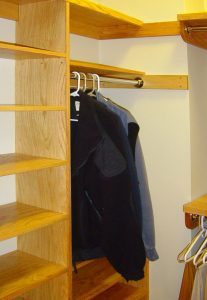03 Sep February-March 2011
Willis Sinclair Homes
“The Lowcountry’s Premier Custom Home Builder”

A beautiful oak closet we built for a client.
24 Gabriel Road
Lodge, South Carolina 29082
843 846 2500

February/March 2011
How do your closets look?
Do you really have the shelves and rods you need in your closet? One of the final touches of an excellent home is a well built and nice looking closet.
Wire shelves are functional, to be sure, but they don’t have that first class touch. If you are thinking about organizing your closet, give us a call.
You have many options. We can build painted, stained or clear finished shelves. The clear finished shelving in the photo was chosen to match the oak flooring.
Rods can be heavy chromed steel as in the photograph, white steel or wooden depending upon your taste.
We have built shoe cubbies and adjustable shelves into closets. The shelves to the left of the hanging clothing in the photo are adjustable. They were designed for sweater storage.
This particular closet also has very high shelves (about eight feet tall – the ceiling is ten feet) for storing seldom used items such as suit cases.
Although this particular closet did not have them, we can also build in drawers and cabinets.
Willis Sinclair Homes
Building (and remodeling) the best possible homes for the best possible price.
843 846 2500
Do you need a new closet treatment to help you get organized? Call us. We will help you think through a design for your specific goals.
 From the desk
From the desk
of Bill Burdick …
Already, the first two months of 2011 is history! Time does move quickly. Children grow up, many adults “grow out”, clothes wear out, cars get worn out and our homes deteriorate. The Second Law of Thermodynamics assures of wearing out and deteriorating.
Take a look around your house. Do you see items that need to be corrected? Rotted wood is a real problem for many homes here in the Lowcountry with its high humidity. Hot summers cause paint to fade and deteriorate. The intense sun will age your roof. If you have shingles on your roof, you will do well to have them last more than fifteen to twenty years.
Many materials will weather well and put off the need for repair or replacement, but no materials last forever.
If you see things that need attention, call or email us. We will help you decide what is important and what is not. We will even take a look at your home for you. We are just a phone call or email away. Of course, there is no charge or obligation for this service.
Bill
Vice President, Willis Sinclair, Inc.
Professional Engineer, Retired
843 846 2500
Paint and Other Finishes
One of the most common characteristics of a house description is the color. For example, my home is white with green shutters.
Paint (and stains) are used to give our homes their color. But, do paints do more than just add color? Obviously, the answer is, “yes”.
In addition to beautifying your home, paints also add a level of protection both inside and outside your home.
Outside you home, paints help protect wood from moisture damage which results in rot, mold and mildew. Some woods are more resistant to rot than others, but all wood rots eventually. Paint helps slow down this process. Rot is a serious problem you should not ignore, especially in humid areas like here in the Lowcountry.
Inside, paint provides a color and a surface which is easier to clean than the native materials. It also hides joints, screws and other imperfections in walls.
What is Paint?
Paint (including stain and other finishes) is a liquid that can be spread over surfaces. The paint then changes to a thin film – about the thickness of a dollar bill – which provides color and protection. Sometimes, the transition from liquid to solid is an evaporation process (paints and stains) and sometimes, it is a chemical change (polyurethane and epoxy).
The reason paints and other finishes are liquid is so they can be applied (relatively) easily.
Why Paint?
As we mentioned, there are two main reasons for painting: aesthetics and protection.
Today, paints are available in nearly any color. They can be custom mixed to match or coordinate with other colors you have in your home.
Protection includes protection from moisture as well as protection from oils and other soiling. Paint also makes it much easier to clean an item.
Types of Paint
There are two basic types of paint: water and oil based. Years ago, water based (or latex) paint was not very good. Today, it is much better. Because of regulations, much paint today is water based. You can look at the clean up instructions on a can to see which type of paint you have.
If the instructions say clean up with warm water and soap, you have water based paint. If mineral spirits, paint thinner or other solvents are needed for cleanup, you probably have oil based paints. Chemically cured paints (polyurethanes and epoxies) also require thinners for clean up.
Sheen
The sheen of a paint is basically how shiny the surface is. Gloss is the shiniest. Flat is the least shiny. The shinier a paint, the easier it is to see surface imperfections. Different paint manufacturers sometime use different sheen names, but common sheen names in descending order of sheen are:
-
Gloss,
-
Semi-gloss,
-
Satin,
-
Eggshell and
-
Flat (or Matte).
Flat paints do not show flaws in walls or other surfaces, but they don’t stand up to cleaning well. Ceilings are often painted with a flat sheen. Sometimes walls are also painted with flat paint. A good quality flat paint typically has a higher percentage of pigments (solids) and thus requires fewer coats of paint than a higher sheen requires. Flat does not stand up well to moisture.
Eggshell or satin are a bit shinier than flat, they clean easier and also show surface imperfections more than flat paints. Often this sheen is used in high traffic rooms. Satin is also used outside because it resists dirt and sun damage more than flat paints.
Trims are often painted with semi-gloss paint because they are more resistant to dirt and scuff marks. If an area will be cleaned often, it needs a semi-gloss sheen.
Gloss paints are not often used inside a house. They are very shiny and sometimes look like plastic.
Alternatives to Paint
Epoxy and polyurethane are not typical paints in that they cure chemically and become very hard. They are also difficult to remove. Epoxy paint is often used on concrete floors. Polyurethane is often used on furniture that will see hard use or as a clear finish on wood trim.
VOCs
Volatile Organic Compounds are chemical compounds which can affect the environment and human health.
Although most (about 90%) VOCs come from plants, solvents are a major source of man made VOCs. Regulations are forcing more paints to aqueous (water) solutions which don’t have VOCs. So far, governments have not tried to regulate Mother Nature….
What Happens to Paint?
Paint has several enemies. The primary one for exterior paint is sunshine. It will cause the paint to fade. The sun can also dry the paint and cause chalking. Sometimes paint exposed to direct sunlight will become extremely hot and blister. The blisters quickly break leaving a bare patch on the surface.
Inside, paint may fade, but usually, it gets chipped or dirty. Sometimes it is damaged from too much cleaning.
What is the difference between $10 and $50 paint?
The difference between different grades of paint is mostly the amount and quality of the solids. The more solids, the thicker the paint dries, the longer it lasts and the better it covers. Since a major cost in painting is labor, it makes sense to use good quality (expensive) paint and paint less often.
Primer
Primer is a special paint designed to bond very tightly to a surface and provide a good surface for paint adherence. Bare materials should always be primed. It is good to “back prime” exterior trim boards (prime all sides) before installing.
Call us if you are thinking of repainting or just wonder about your paint. We can help.
Willis Sinclair Homes, where ‘Built Right’ is the only ‘good enough’ we understand.

Call Us
843 846 2500





No Comments